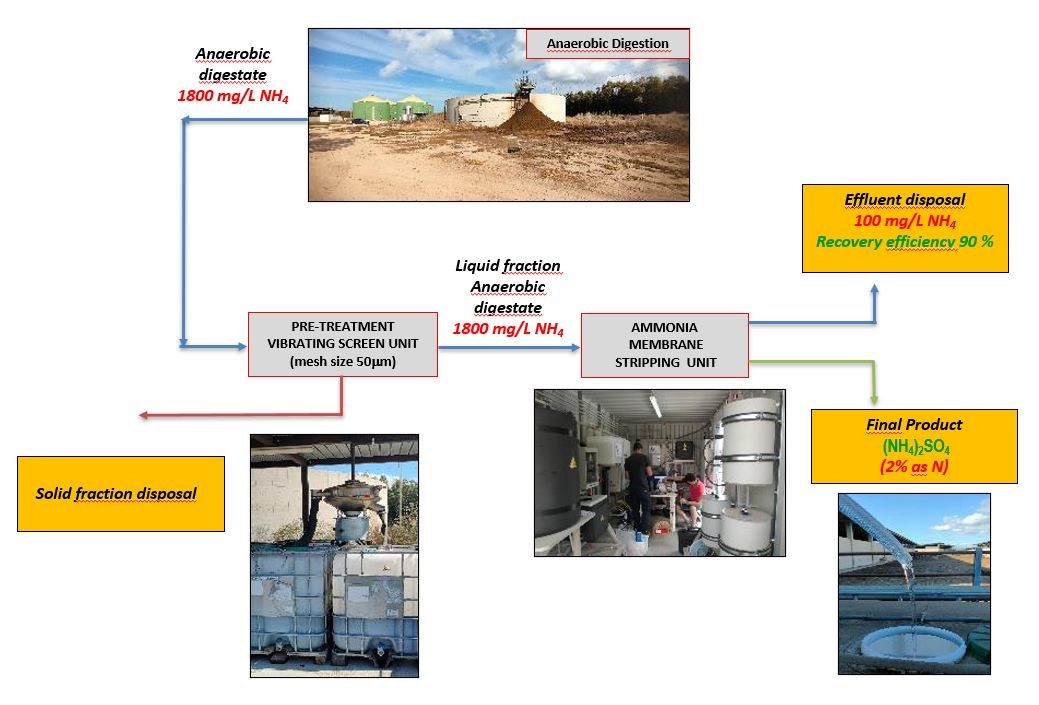
Schema della sezione
-
The prototype for ammonia stripping from waste sludges has been developed by ENAS (Sardinian Water Authority) and CRENoS (Centre For North South Economic Research of Cagliari University) in the framework of the International project "Mediterranean Integrated System for water Supply” (MEDISS) to reduce the impact of ammonia in water and on the soil and to produce low-impact fertilizer for agriculture.
The prototype plant consists of a container equipped with all the necessary equipment, like filtration units, membranes, tanks, pumps, valves, hydraulic and electrical connections, and anything else needed for the proper functioning of the system.
The container makes the plant easily removable and transportable. It is currently located at the Cooperative 'Produttori Arborea' facility operating the treatment of zootechnical waste in Arborea (Sardinia, Italy).
The aim of the prototype is to produce fertilizers in a plant equipped with biogas cogeneration.
Ammonia stripping for fertiliser production was studied in 2012 by the Dutch EAWAG Aquatic Institute and is operational at the Yverdon-les-Bains plant (CH, 2016), but a test at Italian level has never been carried out.
Using membrane filtration units capable of effectively removing ammonia from wastewater flows, it converts it into ammonium sulphate, a fertiliser widely used in agriculture. In addition, the technology allows the coarse portion of the wastewater to be retained and therefore also particles that are potentially harmful to the environment (water, soil, greenery, etc.).

The test, which lasted one year, included 120 production cycles and 2400 samples analysed and resulted in a decrease in the ammonia nitrogen concentration of the digestate by 93% approximately, corresponding to a total nitrogen reduction of about 54%.
Results demonstrated that the ammonia stripping process is an excellent technology to recover ammonia from the digested livestock waste and can contribute to reduce the impact of agricultural activity on the environment.
Fields of application
1- Sludge treatment
2- energy recovery
3- Anaerobic fermentation of biomass and sewage
4- Solar Energy
Target
1- Improved Water Quality: The removal of ammonia from wastewater or agricultural runoff improves water quality by reducing nutrient loading in water bodies, mitigating eutrophication, and protecting aquatic ecosystems.
2- Reduced Ammonia Emissions: By removing ammonia from waste streams, the prototype plant targets the reduction of ammonia emissions into the atmosphere, which can contribute to air pollution and have adverse effects on human health and ecosystems.
3- Enhanced Crop Nutrient Utilization: Applying ammonia-stripped fertilizers to agricultural fields enhances crop nutrient utilization. By providing nutrients in a more readily available form, the prototype plant contributes to better crop growth and yields.
4- Environmental Protection: By mitigating ammonia emissions and nutrient runoff, the prototype plant contributes to environmental protection and conservation.
Preliminary knowledge required (if any)
1- Ammonia Chemistry: Understanding the chemistry of ammonia, its forms in different environments (NH3 and NH4+), and its behavior in various waste streams is crucial for designing effective ammonia stripping processes.
2- Wastewater Treatment: Familiarity with wastewater treatment principles, including different treatment methods and processes, is essential to integrate the ammonia stripping plant into existing wastewater treatment systems.
3- Agricultural Nutrient Management: Knowledge of nutrient management practices in agriculture.
4- Chemical Engineering: Expertise in chemical engineering principles is necessary to design the ammonia stripping process, including the selection of appropriate stripping agents and process conditions.
5- Environmental Engineering: Understanding environmental engineering principles helps in assessing the environmental impacts of the ammonia stripping plant and ensuring compliance with regulatory standards.
References
https://www.bpinventory.com/best-practice/mediss-mediterranean-integrated-system-water-supply
Contacts
Maria Antonietta Dessena
📧mantonietta.dessena@enas.sardegna.it